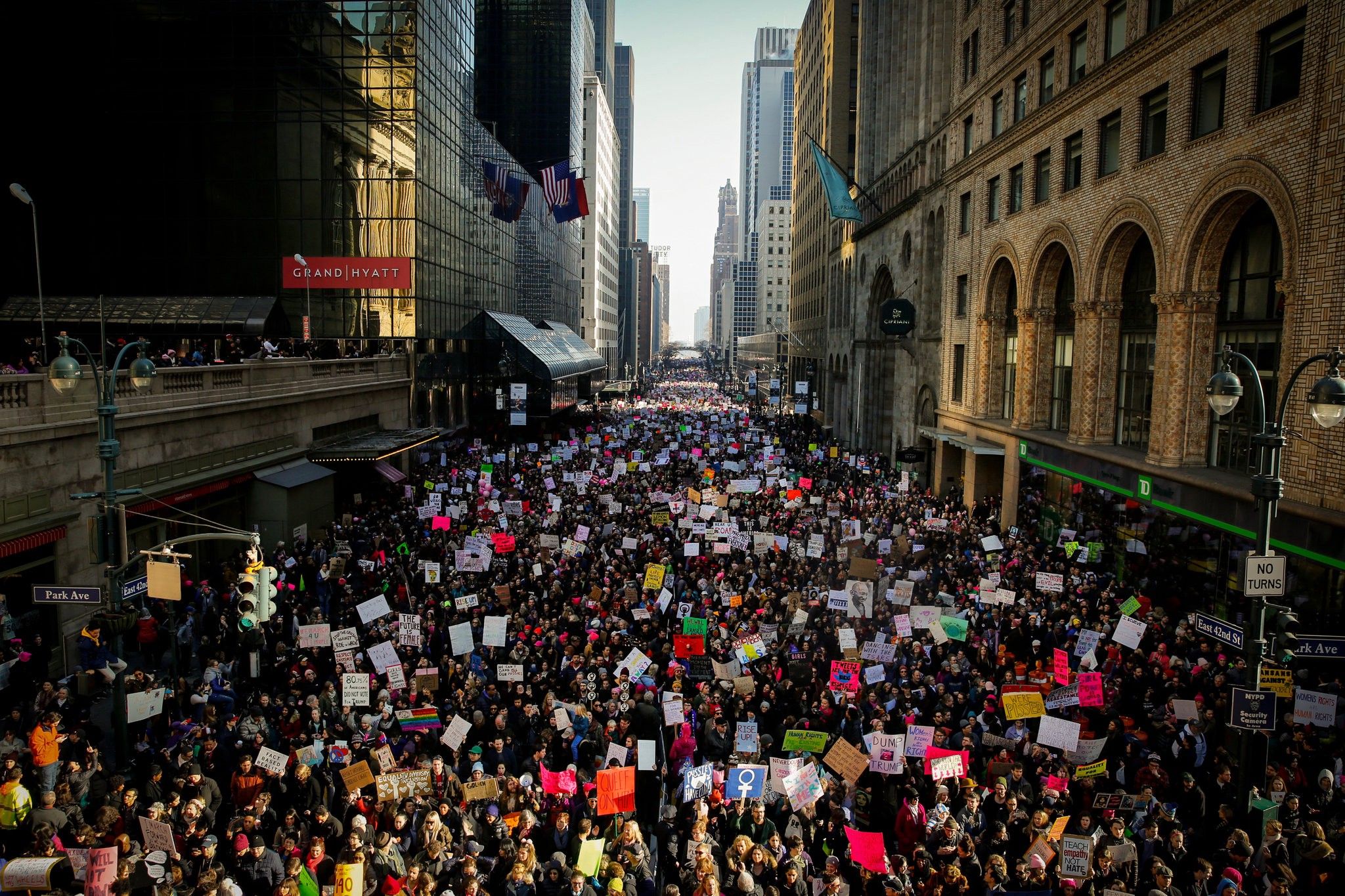We previously exposed the fact that President Donald Trump is fighting a war to protect the establishment from itself, and the rest of us. Now here’s what we do about it.
We’re all feeling it. A sense that, in the Age of Trump, something fundamental has shifted. You feel like you’re going insane. Like everyday brings with it a new battle, a fresh sense of feeling deluged with new, alarming information, the constant experience of being overwhelmed.
In such circumstances it’s not unusual to feel a combination of outrage, resignation, despondency and despair, mingled with internal efforts to re-ignite a sense of pragmatic hope.
But as we begin to develop a systemic, structural and holistic diagnosis of the current moment, doing so opens up greater insight into the possibilities for renewal and revitalization.
To do this, we will deploy a journalistic methodology co-designed in partnership by INSURGE and EXILE. Our approach is an adaptation of the principles of Euclidian geometry, using an analytical framework based on establishing axioms, which we use to explore further postulates, derive meaningful conclusions, and imagine possible scenarios — in a way that allows us to bypass dogmatic polarity, and contribute to a generative dialogue that can advance actionable knowledge.
In How the Trump regime was manufactured by a war inside the Deep State, we set out a systems analysis of how we got to where we are now, giving us insight into how a global systemic crisis threshold has ushered in a conflict at the heart of power.
To explore how we can respond meaningfully to this moment of crisis, we will draw on this and previous work to provide a snapshot diagnosing the fundamental contours of the crisis. This will provide the groundwork to see the crisis for what it is: an act of war on Planet Earth, on all of life, on all of us. Seeing the crisis for what it is, clarifies in a way that is often eclipsed in the everyday what’s really at stake. And this in turn opens us to seeing the possibilities for action, by unmasking the most fundamental obstacle to change: the illusion of our powerlessness, and the mechanisms by which this illusion is perpetuated to ensure the peoples’ silence, fear, apathy and disunity.

1. The diagnosis
It’s now clear that the Age of Trump represents a resurgence of powerful interests tied into a dying civilizational paradigm, being disrupted by converging social, ecological, energy, economic and technological forces.
In this sense, to see Donald Trump himself as ‘the problem’ whose removal would return us to the course of progress would be a grave mistake. Trump is, rather, a symptom of the problem: and the problem is global systemic crisis.
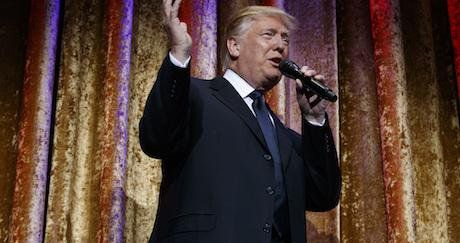
The global systemic crisis can be understood quite simply as an escalating rupture between human civilization and our biophysical environment.
Axiom 1: Our ‘endless growth’ neoliberal economy — along with its constituent technologies of energy, food, and water production, distribution and consumption — are increasingly overshooting the planetary boundaries of our biophysical environment.
In short, every year our consumption of natural resources exceeds the Earth’s capacity to regenerate those resources in that year. Human civilization has been in escalating overshoot since the 1970s.
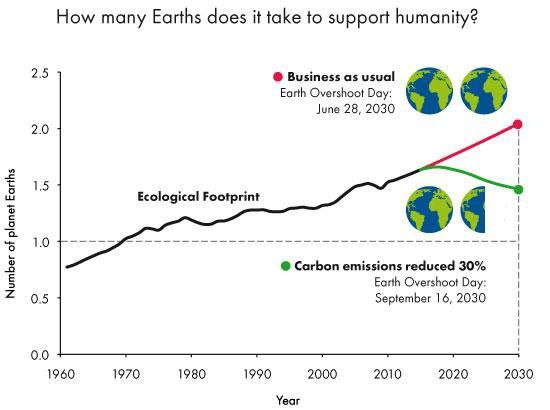
This, in turn, is undermining the stability of our human energy, food, water systems, the wider global economy, and the conventional political frameworks which are supposed to ensure that the former deliver public goods and services.
We have documented this interplay between Human System Destabilization and Earth System Disruption in my new scientific monograph published by SpringerBriefs in Energy:
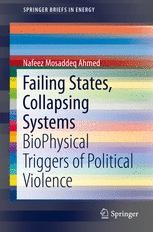
You can read a news bulletin summarizing some of these key findings from the Global Sustainability Institute (GSI) at Anglia Ruskin University’s Faculty of Science and Technology, where I’m a Visiting Research Fellow:

One of the fundamental biophysical drivers of the global systemic crisis is global net energy decline. Global net energy decline doesn’t mean we are running out of oil, or other fossil fuels — it means that the net value of the energy we are able to extract from our fossil fuel resource base is declining inexorably, despite increases in production.
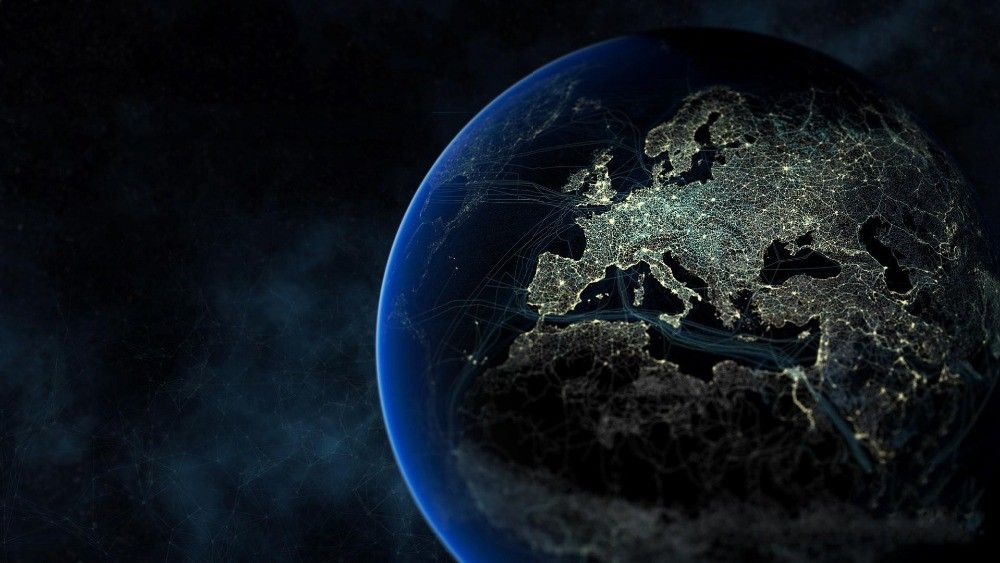
There was a time in the US, around the 1930s, when the EROI of oil was a monumental 100. This has steadily declined, with some fluctuation. By 1970, oil’s EROI had dropped to 30. Over the last three decades alone, the EROI of US oil has continued to plummet by more than half, reaching around 10 or 11.
This is happening as we’ve had to shift away from plateauing conventional oil, to more dirty, more difficult to extract, process and refine, and more expensive forms of oil — leading to a new era in which the costs of fossil fuel production are far higher.
In this context, the drop in the market price of oil due to the fast drilling economics of the fracking ‘revolution’ is not a signifier of ‘cheap energy’, but entirely the opposite: the declining profitability of producing oil because it doesn’t generate enough profits relative to the escalating costs of production.
According to environmental scientist professor Charles Hall of the State University of New York, who created the EROI measure, global net energy decline is presently the most fundamental biophysical driver of persistent global economic malaise. Because we need energy to produce and consume, we need more energy to increase production and consumption, driving economic growth. But if we’re getting less energy over time, then we simply cannot increase economic growth as much as we’re used to.
This means that there’s not enough energy in the system for the economy to afford to pay for the higher cost of fossil fuel production — that’s another reason why the market price of oil has plummeted: from an energetic perspective, the economy is struggling to afford the higher cost of producing a barrel of oil.

Axiom 2: Global net energy decline means that the net value of the energy we are able to extract from our fossil fuel resource base is declining inexorably, despite increases in production — and this is exerting an increasing geophysical brake on the global economy’s capacity for growth.
So let’s be clear: neither liberal nor conservative paradigms, both built on a foundational belief in the neoliberal ‘endless growth’ capitalist economy as integral to human progress, offer meaningful answers to the Crisis of Civilization — our present business-as-usual course still veers toward an uninhabitable planet.

As global net energy is declining, to keep the endless growth machine running, the imperative to drill like crazy to get more energy out only deepens. So instead of scaling back our exploitation of fossil fuels, we are accelerating it.
As we are accelerating fossil fuel exploitation, this is accelerating climate change. That in turn is driving more extreme weather events like droughts, storms and floods, which is putting crops in major food basket regions at increasing risk.
The environmental crisis has culminated in a shocking tipping point, whereby we have breached several key “planetary boundaries” for the safe operation of human civilization, further amplifying Earth System Disruption.
As climate and food instability ravage regions all over the world, this has fueled short-sighted government responses in the form of military interventionism, heightened geopolitical competition, and the militarization of national borders.

It has also accompanied more planning from government security agencies for domestic counter-insurgency operations in preparation for these processes to undermine domestic stability.

Axiom 3: Climate, water, food, energy and geopolitical crises are not simply separate, distinctive processes — they are fundamentally, systemically interconnected: we are facing a single, overarching Crisis of Civilization.
When we attempt to understand these interlocking processes through the lens of complex systems theory, the critical role of information in the future of human civilization becomes crystal clear.
Evolutionary biology teaches us that when a complex adaptive system is particularly challenged by its environmental conditions, it enters a stage of crisis. The crisis challenges the existing structures, the existing relationships and patterns of behavior in a system. If the crisis intensifies, it can reach a threshold that undermines the integrity of the whole system. Eventually, either the system adapts by re-structuring, leading to a ‘phase shift’ to a new system, a new equilibrium — or it regresses.
In a civilizational context, the capacity to process information in such a way that it is distributed effectively across the system to contribute to resilient relationships is crucial to the system’s ability to survive, and adapt. In this sense, the state of our communications and media systems presents an insightful barometer of the health of the ‘DNA’ of our civilization.
It doesn’t matter which side of the political spectrum you sit on. We are all feeling it, acutely — a deep sense of acceleration and polarization, signalling that our information sensors are in increasing disarray, overwhelmed, unable to cope with and meaningfully process the avalanche of seemingly contradictory, confusing and frightening data entering our consciousness.
Axiom 4: The state of information overload and polarization we are now experiencing speaks to the fact that we are rapidly approaching a global systemic crisis threshold. The crisis has overwhelmed the existing structures of the global system. Our prevailing institutions and systems of power are in informational disarray as they struggle to make sense of what appears to be an overload of information signalling this systemic crisis.
At this point of threshold, the system faces a crisis of information overload, and an inability to meaningfully process the information available into actionable knowledge that can advance an adaptive response. Hence, for instance, the increasingly toxic polarization of all political discourse.
This deepening polarization, the retreat of different communities into fragmented self-reinforcing, self-enclosed ‘bubbles’ of communication, reflects a rupture that has opened up in the heart of power itself: the Deep State.

As 28 year Congressional insider Mike Lofgren observes, the Deep State is not a unified entity, but a divided conglomerate of competing groups who operate ‘hidden in plain site’ outside, over and above the civilian government (even while they try to influence it).

Deep State actors do not, largely, understand the systemic nature of the crisis. Even if they have some semblance of a systemic view, its efficacy is neutered by narrow and often self-serving ideologies. Donald Trump represents a faction of the Deep State which believes that both the liberal and conservative establishments have failed: the liberals are blamed for having created the crisis; the conservatives are blamed for having failed to stop the liberals from failing.
The Trump regime thus represents a violent radicalization of conservative ideology, resulting in the resurgence of a powerful elite nexus of American white nationalists, corporate globalists and fossil fuel industrialists with extensive ties to the military-industrial complex.
The rupture within the Deep State now highlights exactly what is at stake: The reigning ideology of the Trump regime seeks an acceleration and consolidation of the existing structures of the global system.
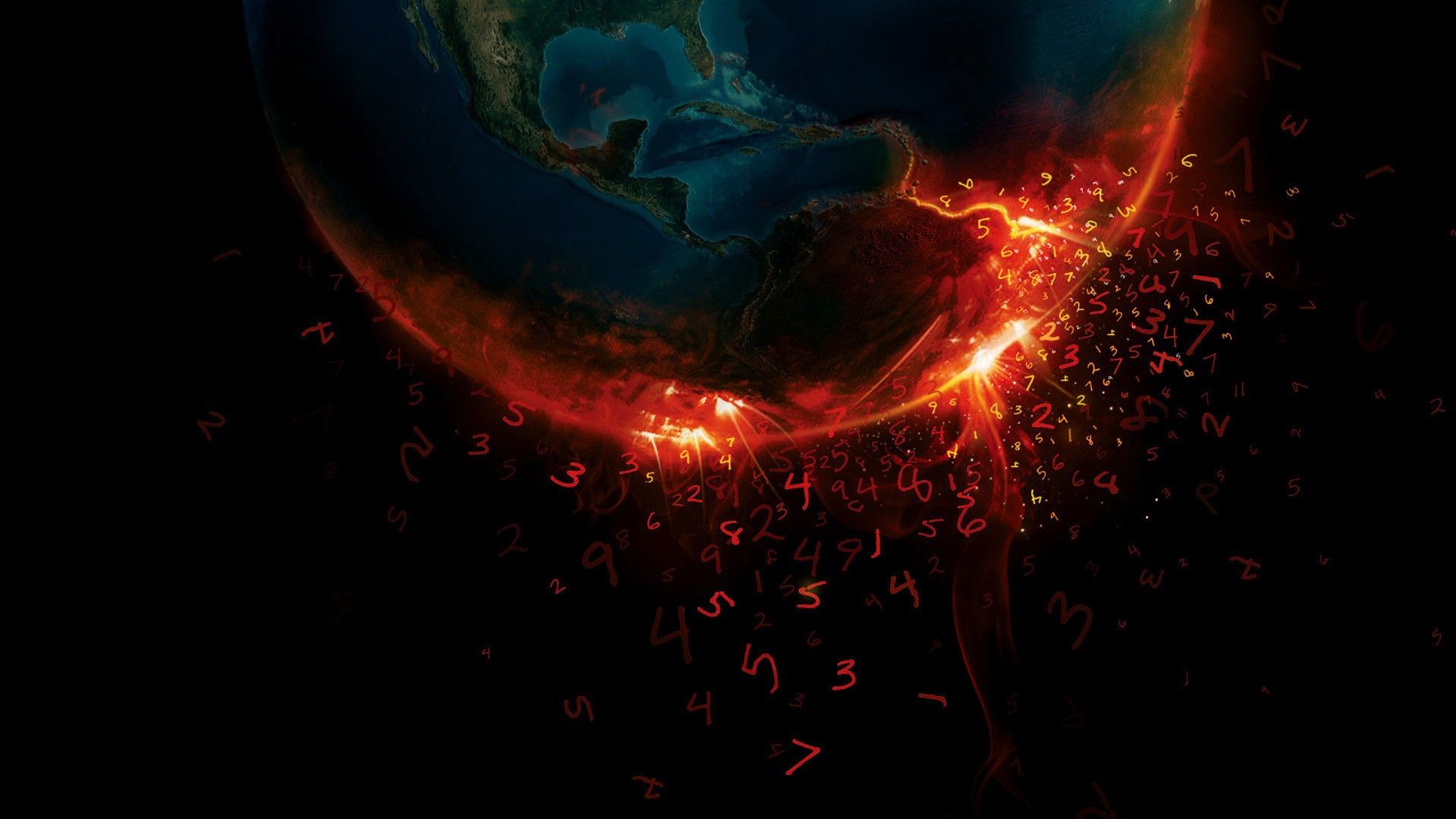
2. The war on all of us
Rather than recognizing the disruption of the global system for what it is — symptomatic of the unsustainability of prevailing structures requiring an adaptive global phase-shift to a new system — the Trump regime represents a powerful cross-section of American elites who see this disruption as a threat to their hegemonic power.
Rather than recognizing the role of the structures of the global system itself in accelerating this disruption, they blame and Otherize the problem onto a cast of conveniently-defined ‘Outsider’ groups.
A glimpse of this ideology can be found in an extraordinary statement put out by Joseph Bast, the CEO of the climate-denying Heartland Institute, introducing its latest Quarterly Performance Report. Heartland has been funded by the same fossil fueled forces behind Trump: ExxonMobil (whose former CEO is now Trump’s Secretary of State) and the billionaire Charles Koch.
The Heartland statement makes an astounding declaration whose implications require careful contemplation: It announces in no uncertain terms that there’s a war going on — that this is an existential crisis, and that the interests behind Trump are quite literally waging their war to save ‘capitalism’ from those seeking to destroy it:
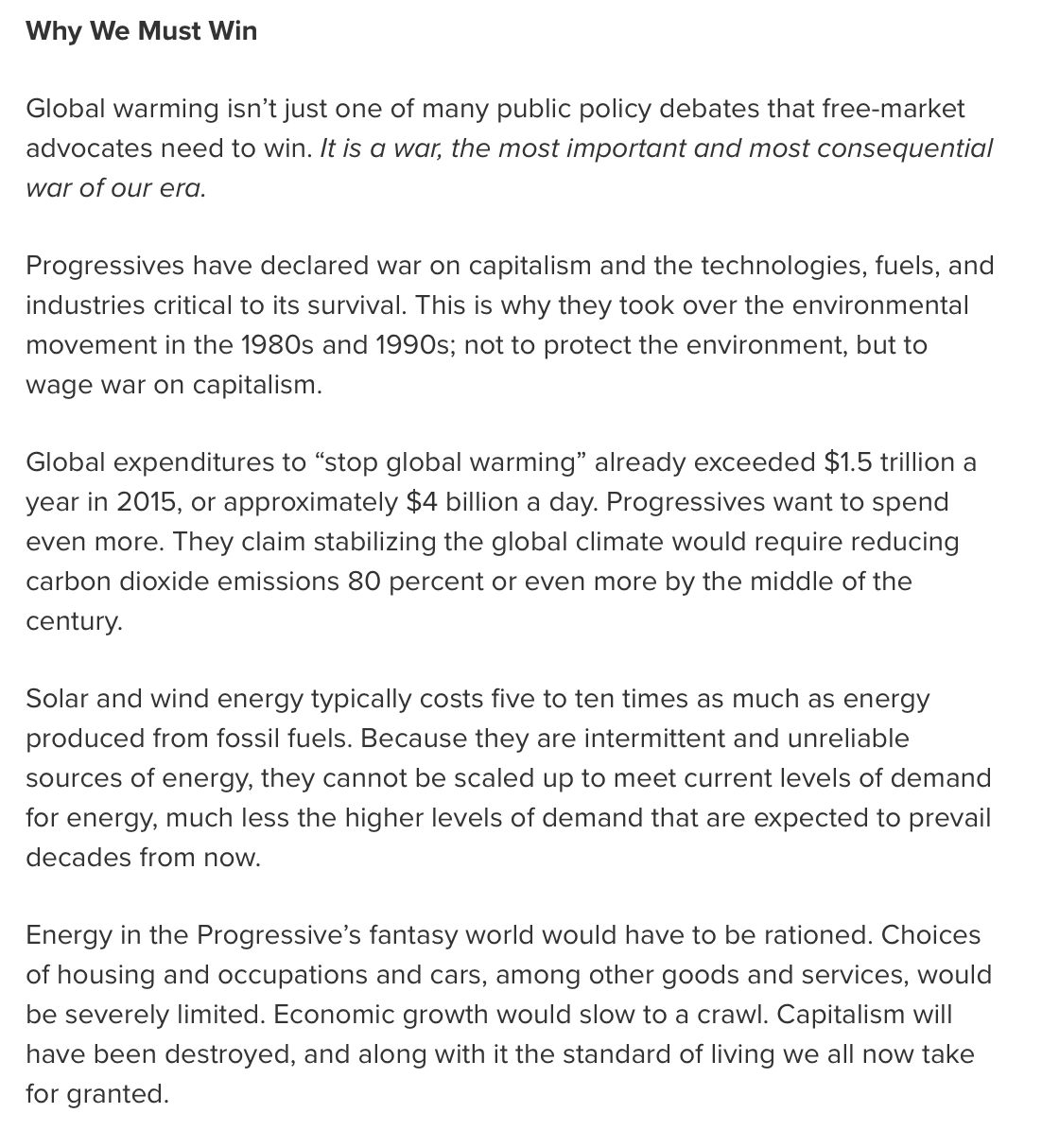
The Heartland statement shows that the interests behind the Trump regime have convinced themselves that liberal, progressive support for the clean energy and climate movements threatens to destroy ‘capitalism’.
But liberals and progressives are not destroying capitalism. Neoliberal capitalism is eating itself, and the myopic logic of endless growth is overconsuming its own biophysical resource base.
So in reality, this war is between the past and the future: between a fossil fuel-centered paradigm of endless material growth, which is entering its death throes; and an emerging paradigm of prosperity for all, which respects planetary boundaries and defers to the natural environment.
Rather than accepting the global systemic crisis for what it is, Heartland is clinging to an outmoded worldview, technology and resource-base — and an associated economic and political paradigm. It can be summed up in the following screenshot from Heartland’s Quarterly Report, promoting a book called “Clexit”:

Compare this to the simple facts around global net energy decline as identified here: the Energy Return on Investment (EROI) of fossil fuels is in terminal decline, despite improvements in technological productivity, production increases, and intensified drilling.
The Trump regime’s model of economic growth is, itself, destined to undermine economic growth in the long-run. But the Trump regime and its benefactors are ready to blame everyone else for that very phenomenon — everyone except themselves and their outmoded, dysfunctional policies.
The Heartland statement thus leads to the following stark conclusion. The interests behind the Trump regime represent the violent radicalization of the old paradigm: the political economy, ideology, culture and value-system of extraction.
So yes, there’s a war. But it’s not a war between liberals and conservatives, between climate activists and fossil fuel industrialists.
Axiom 5: This is a war between an old, dying paradigm, and an emerging new paradigm that is rapidly and concurrently disrupting the old paradigm, here and now.
It’s a war between the old, dying paradigm based on ceaseless material production, consumption and acquisition by atomized, disconnected and competing individuals, which elevates greed and egoism by seeing them as rational virtues for the public good—a paradigm whose business-as-usual trajectory, premised on one-sided destructive relationships of extraction and exploitation, is in reality heading toward an uninhabitable planet; and an emerging paradigm based on living and working in harmony with our natural environment and each other, as diverse and different communities who nevertheless see ourselves as embedded in our environment and mutually interconnected.
This in turn highlights a paramount reality. The ideology, value-system and political economic structure of the old, dying paradigm of endless extraction, has thoroughly outlasted its usefulness.
It is no longer a force for progress, but threatens the very survival of the human species.
The Heartland Statement thus reveals what is truly at stake: the interests behind the Trump regime are waging a global war, and they will not stop until they annihilate their perceived enemies. It is a war in which the future of all life on the planet hangs in the balance. It is a war on our children, and their children, and theirs. This is a war on the Earth itself.
Conversely:
Axiom 6: The ethically-driven vision, values and political economy of the emergent paradigm that seeks relationships of regenerative mutuality based on the interconnected ecology of life and the cosmos — exemplified in the moral imaginations we codify with the terms love, justice and compassion — represents a highly functional evolutionary systemic adaptation that is, in fact, essential for the survival and prosperity of the human species.
In the emerging paradigm — the paradigm we must unearth, practice, embody and institutionalize as part of an evolutionary systemic adaptive response to the present crisis — we see more to life and work than endless material acquisition.
We ground ourselves in ethical imperatives of love, compassion, justice and generosity, whose behavioral manifestations are precisely to connect us with each other and the world in healthy, productive relationships of equity and mutuality.

3. The first casualty: your mind
It is no surprise, then, that the self-assertion of the faction behind Trump, does not represent the will of a majority of Americans. Of the 227 million eligible American voters, just a quarter voted for Trump. Around a quarter also voted for Clinton, albeit a slightly higher number than voted Trump. A tiny minority voted for third party candidates like Jill Stein of the Green Party. And everyone else, fully 42% of eligible voters, just refused to vote.
Axiom 7: A vast majority of eligible American voters are not Trump supporters. This, of course, is a powerful signifier of the extent to which Trump’s victory represents, and was enabled by, a fundamental erosion of the public sphere. The war on all life and the Earth itself begins and ends with the war on the public sphere.
It was a victory carefully reprised through multiple deceptions: The war on all life and on the Earth itself can only be won by destroying and subjugating the public sphere; so that whatever feeble ‘resistance’ the public sphere offers can be duly shocked into submission, ideologically, intellectually, emotionally, psychologically.
One mechanism appears to have been the systematic suppression of Black and minority votes in 27 key Republican states. Another was the use of social media, utilizing similar techniques that have long been researched and honed inside the bowels of the Pentagon and other agencies.
As an investigation by Scout has shown, the ‘alt right’ has made major strides in ‘weaponizing’ artificial intelligence (AI) to harness Big Data: developing personality profiles of members of entire populations, by which to manipulate their psychologies.
Trump’s chief strategy advisor, Steve Bannon, sits on the board of one key organization, Cambridge Analytica, which — supposedly — boasts the ability to predict a subject’s behavior even better than themselves based on analyzing just 300 Facebook likes. The firm now maintains a database of fully 200 million Americans — based on data derived from extensive social media surveillance, as well as the purchasing of other personal and consumer data from private sources.
Cambridge Analytica used “behavioral micro-targeting” during the US elections by planting Facebook ‘dark posts’ — targeted ads that are only visible to the target — in swing states. By monitoring the way people reacted to these ads, they were able to assess and fine-tune their messaging. These methods are combined with the creation of extensive ‘fake news’ media websites and networks, which over many years have honed the techniques of search engine optimization to position themselves at the top of relevant Google searches; as well as the systematic use of social media ‘bots’ to advance partisan narratives and silence opposing views.
The extent to which these methods actually influenced the US elections is unknown — and potentially unknowable, precisely because all the relevant data to determine their effectiveness is held by private firms like Cambridge Analytica. But as Scout reports, these methods are not just being used by the ‘alt right’ and conservatives — they’re also being used by liberals.
Similar methods were used by the Clinton campaign, in some ways with far deeper sophistication. And as INSURGE intelligence has previously reported, government security agencies took the lead in developing these technologies to influence the beliefs of civilian populations as an integral part of military and intelligence operations, at home and abroad.
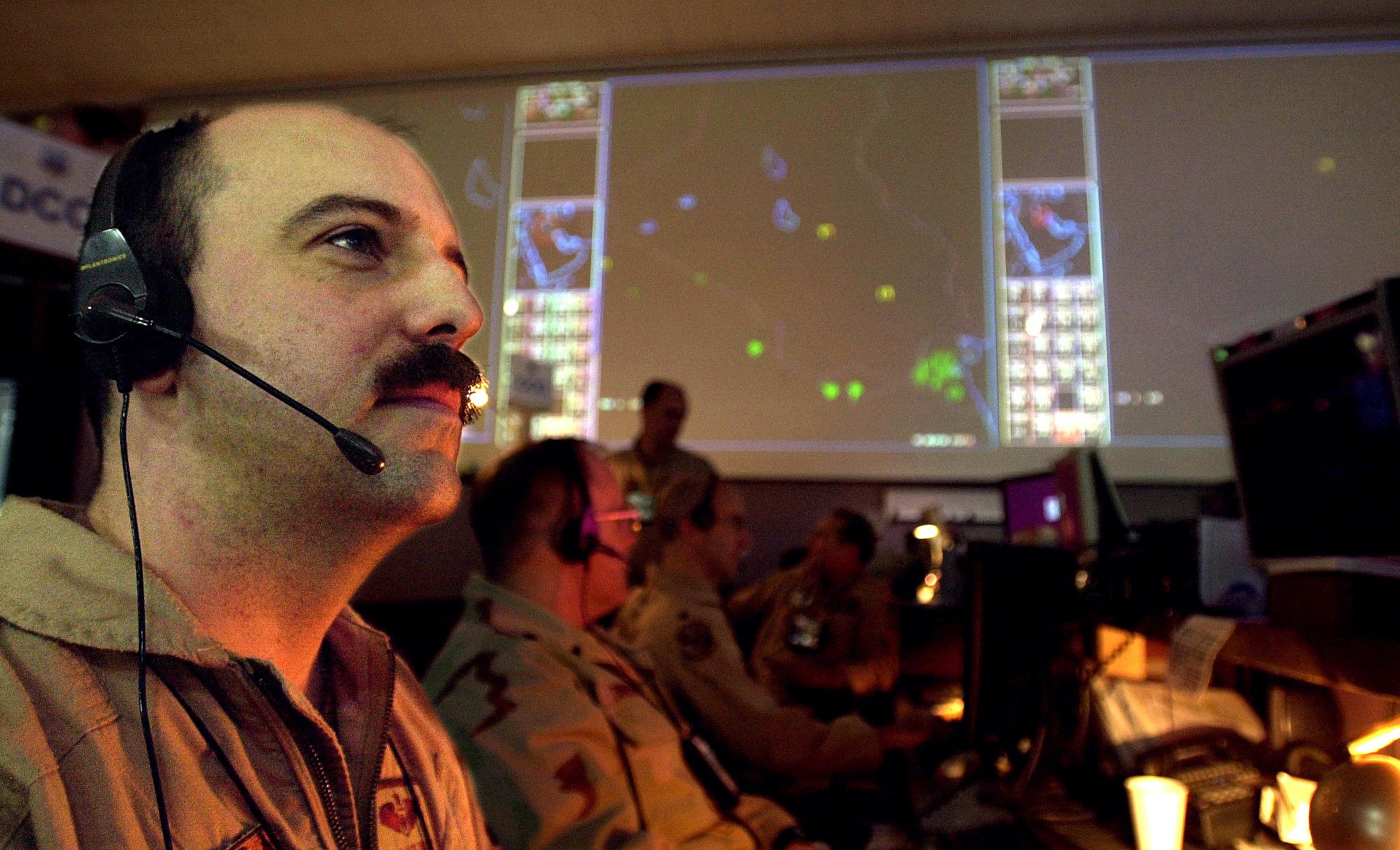
And methods like this will increasingly be used in future by political parties, governments and the private sector, with a corrosive impact on generative political dialogue and democratic discourse, because no one will be able to independently gauge the full extent of its impact.
From this vantage point, the AI Singularity doesn’t look so wonderful anymore. Instead, it looks like a Death Machine.

What does this mean? It means, to quote Flobots, there’s a war going on for your mind.
The point of this is that the war within the Deep State, along with the war between conservative, liberal and ‘alt right’ political polarities, is increasingly being fought to influence your beliefs, emotions and behaviors in a way that is toxic, polarizing, invisible and unaccountable.
This is how the public sphere is being slaughtered, again and again and again. And this is how the war on all life and the Earth itself is able to accelerate and intensify, while we watch, eat, buy, swipe our smart-screens, and endure restless sleep.
Axiom 8: While the information sensors of human civilization are already in disarray, this information war fought from multiple fronts — by the liberal, conservative, government and corporate establishments — seeks, fundamentally, to manipulate your beliefs and behaviors.
No wonder, then, that this political atmosphere produces a sense of apathy and resignation — a sense of atomization and, ultimately, powerlessness.
We are made to feel that our individual roles are merely to choose where we sit passively within a spectrum of banal political polarities that benefit powerful interests, competing with each other for influence over our minds, our feelings and our behaviors.
We are simply cogs in a machine of endless production and consumption whose final logic is to concentrate wealth in the hands of a powerful minority at the expense of people and planet.
Therefore, this sense of powerlessness and despondency that we feel in the face of the overwhelming nature of the crises before us, does not necessarily reflect the reality of what is possible at all. In fact, it doesn’t — it reflects our mode of being within the system as it stands, today.
The sense of powerlessness reflects how the conventional institutions of liberal democracy have led to the erosion of the public sphere as a space of meaningful democratic empowerment.
Axiom 9: The feeling of powerlessness is, in itself, an integral feature of global systemic crisis, a symptom of a system that is failing, a paradigm that has outlived its usefulness.
In recognizing this, we can begin to see that the feeling of powerlessness is illusory: it reflects the system itself, but does not reflect the reality that within the very crisis-threshold that the system is now experiencing, within the unprecedented rupture that is opening up, there is an equally unprecedented opportunity for radical transformation.
The present moment in the Age of Trump has seen a range of some of the most powerful but regressive political, economic and ideological forces capture the American government; in turn, this has unleashed a great awakening across the spectrum of political polarities.
People who identify as liberal, conservative and neither are, together, waking up; they are recognizing the unprecedented nature of the concurrent acceleration, the weakness and ineptitude of our institutions of liberal democracy. People who have never been interested or engaged in politics want to resist.
But action must not be limited to ‘resistance’ — because resistance occurs within the parameters of the existing system as a form of reaction, which the system is already prepared to respond to.
We must go beyond resistance toward transformation: we must evolve beyond the institutions that not only failed to prevent, but ultimately facilitated, the rise of Trump; we must re-claim power by re-building the broken public sphere whose erosion enabled this very moment of escalating crisis.
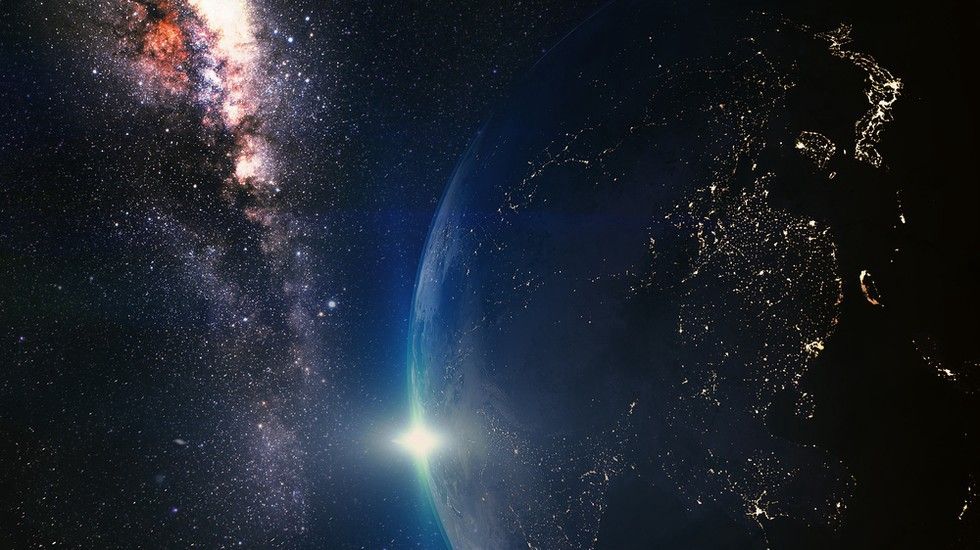
4. From powerlessness, to acceptance, to creation
But how? As a journalist and activist, I’m no stranger to the feelings of disillusionment and despair that can arrive after realizing that a life-time’s worth of struggle does not readily appear to result in the change we want to see in the world.
These feelings often resurface at times of acute crisis. Many of my friends and colleagues have experienced an enduring sense of depression in the Age of Trump. Recently, I experienced a baffling sense of disbelief in my own work, including my ongoing partnership with EXILE to build the next generation media platform of INSURGE intelligence, a project that we’re accelerating right now.
The experience consisted of a tightening sense of disbelief in the very possibility that our project would be capable of reaching fruition; it was accompanied by an all-encompassing sensation of despair.
Maybe it was related to the Trump Fallout — the feeling of ‘resistance fatigue’ that so many experienced when they realized that all their hard work to build a better world, all the small but big victories on the environment, minority rights, healthcare for the poor and so on, were about to be undone.
When I confronted these intrusive sensations, I had a profound realization: one that I’ve experienced before, but whose reality hit me anew with fresh wisdom. And that was acceptance.

I stopped trying to fight the feelings of despair, depression, disbelief, darkness. Instead, I just sat with them, looked into them, and let them speak to me. And when I did so, I realized that I needed to accept my limitations. I needed to accept what lays beyond my control. I needed to accept that I don’t control the outcome. To come to terms with the grief of that acceptance.
And in accepting, fundamentally, that my immediate power may not in itself be capable of changing the entire system — in accepting that I do not have the power to change the world — I discovered the nature of true power.
I realized where my power really can be found: in myself, and in my context.
Only by accepting, becoming at peace with, the limitations of our power, will we stop wasting our time trying to change things outside of our power to change, and begin focusing our efforts on changing what is precisely within our power to change.
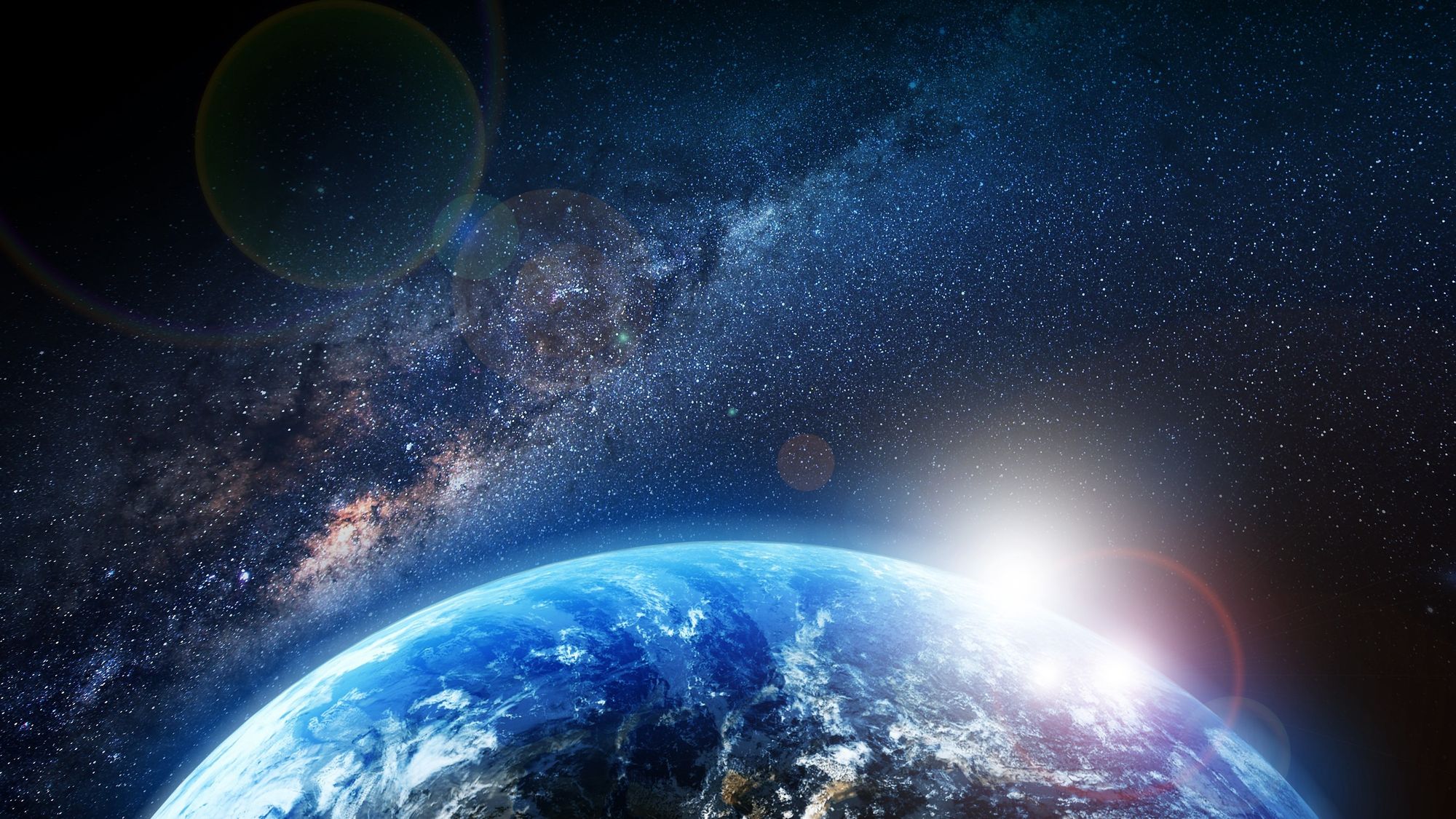
The first step, then, was to assess myself. Who am I? What do I have to offer? What are my skills, my interests? What are my passions? What is the gift I want to bring to the world? How can I embody the change I want to see in the world? How can I live and work in a way that that breaks free from the old paradigm, and brings me closer to the new paradigm?
That, too, requires considerable inner-work. It requires understanding the extent to which our neurophysiologies are wired and constantly, literally, programmed by the informational bombardment of competing political polarities and mass consumerist modalities.
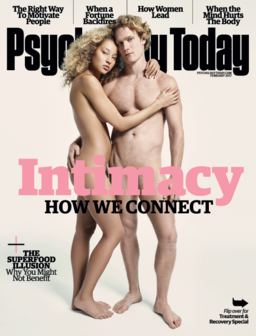
We are wired by this system to be cogs in the machine, unable to think critically, fearful of authority, convinced of our powerlessness, and locked in a cycle of producing and consuming to a tune not of our own making.
This internal wiring is no accident. It is entirely intentional, and remains so.
One of its early pioneers, Edward Bernays — the ‘founding father’ of modern public relations — not only worked for some of America’s biggest and most powerful corporations, but also for the US government. Among his government activities, Bernays worked in President Woodrow Wilson’s Committee for Public Information, producing propaganda to drum up American public support for US entry into the First World War. He went on to get hired by the White House to improve the image of President Calvin Coolidge, and was appointed by President Hoover to his three-man Emergency Committee on Employment.
Later, Bernays was hired by the US-based United Fruit company, to run a propaganda campaign against the popular democratically-elected president of Guatemala, Jacobo Arbenz. Upon coming to power, Arbenz had proceeded to fulfil his campaign promise of nationalizing and redistributing land owned by United Fruit back to ordinary Guatemalan peasants. So on behalf of United Fruit, Bernays galvanized a powerful campaign to get the US media to run stories portraying him as a communist threat with dangerous ties to the Soviet Union.
The entire liberal and conservative press largely bowed to this early wave of ‘fake news’, which — illustrating the pathetic levels of ideological self-delusion that saturates our societies — remains largely unknown (despite being well-documented). United Fruit’s goal was to push President Eisenhower into an intervention in Guatemala — Bernays campaign succeeded, ultimately resulting in the 1954 CIA coup.
The CIA installed Colonel Carlos Castillo Armas, who promptly ensured that United Fruit re-confiscated the land distributed to Guatemalans, eliminated taxes for foreign corporations, and embarked on a dirty low-intensity war against opponents of the CIA-backed dictatorship, culminating in over 200,000 deaths.
Bernays’ methods were even applied by the Nazis. Hitler’s Minister of Propaganda, Joseph Goebbels, praised Bernays’ book, Crystallizing Public Opinion, for helping to craft the Nazi regime’s efforts to influence German public opinion.
Here is an illuminating excerpt from Bernays’ 1928 book, Propaganda, which lays out the morose philosophy of power that underlays so much of conventional democratic politics:
“The conscious and intelligent manipulation of the organized habits and opinions of the masses is an important element in democratic society. Those who manipulate this unseen mechanism of society constitute an invisible government which is the true ruling power of our country. We are governed, our minds are molded, our tastes formed, and our ideas suggested, largely by men we have never heard of… It is they who pull the wires that control the public mind.”
This is critical to absorb: Bernays, a key creator of these methods of modern propaganda who helped the US government, the CIA and American corporations to hone and execute them, saw them not as simply instrumental or accidentally useful: he saw them as essential tools for the “conscious and intelligent manipulation” of the public sphere. And he believed this was a ‘good thing’, an integral component of a stable “democratic society.”
This sort of intentional effort to manipulate our beliefs goes on today in all sorts of ways: one of the most powerful arenas is through entertainment. Countless Hollywood films are created with the influence of the Pentagon and the CIA.

Bernays thus highlights one of the deepest limitations of liberal democratic structures in their current form:
Axiom 10: It is in the interests of government and corporate actors to erode the public sphere, to muddy the capacity for meaningful generative public discourse premised on the empowerment and cognitive clarity of individuals; because doing so enables them to maximize wealth extraction for themselves, at the expense of people and planet. As such, we have been wired to deny our own power, and to say ‘no’ to possibility.
As noted by Professor Richard Gunderman of the Indiana University’s Center for Bioethics:
“Bernays pioneered a form of branding, but at its core it represents little more than a particularly brazen set of techniques to manipulate people to get them to do your bidding.
Its underlying purpose, in large part, is to make money. By convincing people that they want something they do not need, Bernays sought to turn citizens and neighbors into consumers who use their purchasing power to propel themselves down the road to happiness.
Without a moral compass, however, such a transformation promotes a patronizing and ultimately cynical view of human nature and human possibilities, one as likely to destroy lives as to build them up.”
Whether he knew it or not, the techniques of cognitive manipulation that Bernays introduced into the corporate and government playbook are intimately tied to the fundamentally flawed, instrumentalist old paradigm of endless extraction — they are part and parcel of the same reductionist view of human nature, power and possibility that seeks to render us as mere ‘powerless’, disconnected consumers of material stuff, a paradigm that is not only cannibalizing itself, but endangering all life on the planet.
Our current cognitive and neurophysiological wiring is irretrievably bound up with this system of governmental and corporate propaganda which pervades all areas of our lives as a sort of hyperreality; which seeks actively to minimize our consciousness of our real power; and to reduce us to mere passive wage-labourers and mass consumers who truly believe there is nothing more to life and reality than this state of profound alienation from ourselves, each other, and our environment.
Axiom 11: Our present cognitive and neurophysiological wiring ought to be interrogated, undone, re-constituted. We can re-create ourselves anew, as carriers and enablers of the emerging paradigm that we wish to see in the world, and wish to be part of.
By breaking free of this wiring, we enable cognitive and neurophysiological breakthroughs that can allow us to see, live and work in the world as it really is — rather than as the beneficiaries of Bernays’ worldview see, live and work in it.
We therefore move from self, to society.
The second step is to assess our social context to identify the gaps, the needs, the issues that urgently require redress as a consequence of the ravages of the old paradigm: my family, my community, my social network — and by that I don’t mean my virtual social media network, although that can be a part of it, but more concretely, my physical social network of people around me, who I’m connected with in and through the real-world.
What are the issues or problems that I can contribute to resolving given who I am, my skillset, my passions? And who can I work with in my context to do so? How does my context intersect with the contexts of other individuals, people, communities, organizations?
5. Toward a civic democracy
This lays the groundwork for transformative social action — defined as transformative by the extent to which it is capable of breaking with the old paradigm, and ushering in the emergent paradigm.
And that leads to the third step: to create something new, as part of a collective that connects one’s self to that wider context. How can I bring who I am productively and constructively into relationships with these real-world networks so that we can, collectively, create something new which fundamentally breaks with the old paradigm and brings forth the emerging paradigm — that fundamentally disrupts the old, and innovates a breakthrough revolutionary way of seeing, living, working, doing for yourself and those around you?
My colleagues at EXILE have developed a model that advances this basic three-step structure into a concrete blueprint for civic democracy that spans seven core areas/contexts.

These areas provide practical markers and guidelines for any individual or group that is actively seeking to explore how they can move through these three steps, out of the state of powerless and despair, into acceptance and finally actual creation, depending on which area/context one finds oneself:
- corporate innovation — building capacities to create economic alternatives that benefit people + planet
- startup development — building companies that solve real economic & ecological problems
- market ecosystems — building alliances that allow companies and organizations to cooperate and compete over value creation
- media reform — developing solutions that elevate thinking & coordinate action beyond op-eds and biased outlets
- educational reform — developing solutions that incite critical discourse & foster creative literacies
- social reform — working amid very challenging socioeconomic conditions to develop alternatives for leadership in poor or disadvantaged communities
- policy reform — developing frameworks that align coordinated action with visions that are equitable between civic and commercial domains
This applied blueprint moves fundamentally by recognizing that liberal democracy as it stands, while having brought important dividends, has not only failed to stop, but has largely allowed vested interests to continue concentrating their control at the expense of people and planet.
The Age of Trump precisely highlights the failures and vulnerabilities of our current democracies, and their constant manipulation by vested interests.
Axiom 12: We require an evolutionary adaptation, where citizens themselves take on the responsibility, and embrace their power, to collectively build and re-build institutions, companies, businesses, nonprofits, communities, markets and ecosystems, which function in the interests of people and planet — which serve them, and not parasitical vested interests. The imperative to re-build the public sphere by building civic democracy is, therefore, about overcoming our crisis-threshold, and transitioning through an evolutionary adaptation to a new system.
The new emerging system will not simply do away with the old; rather it will reconfigure, transfigure, modify and utilize elements of the old, incorporated into a new system that fundamentally transcends its failures and limitations.
The EXILE blueprint provides one powerful example of how this civic democracy model works that draws on direct experience.
In the 1990s, Dr. Linda Erwin pulled together a multicultural, multidisciplinary team to address the rising crisis of gang violence in the Pacific Northwest. The team brought in multiple practitioners each with their own skill-set and expertise: educators, judges, surgeons, activists, poets, actors, case workers, probation and police officers, prison leaders. EXILE’s Andrew Markell was one of these practitioners.
The team had carte blanche to combine their multiple specialisms into an integrated set of interventions designed to deliver a program of transformation for the young people participating. The program sought to train these young people in leadership and self-mastery, while providing them with tools to understand power and the illusion of power. This served as the groundwork to develop skills and practices that empowered participants to build new lives beyond the systems and institutions that incubated violence.
As the program grew, the participants — who were once high risk youth or gang members themselves — became enrolled as paid facilitators and, ultimately, ambassadors. In turn, they travelled to different parts of the country, training others in the same way, building new programs, testing the methodologies they had learned in new contexts, and galvanizing change on a national scale for disadvantaged communities.
One signal of the power of this work is that Dr Erwin won the National Crime Prevention Council’s Ameritech Award of Excellence for her integral role in creating this initiative. Her praises were even sung in US Congress. In Markell’s words:
“We trained everyone in core leadership and self-mastery skills. We influenced policy, not by manipulating it, but by providing interpretive frameworks. We built holistic programming grounded in the cultivation of solidarity and strategic alliances that cut across previously unconnected groups of stakeholders in the system. We rooted all our designs in local conditions and we took seriously the mandate that at the core, if we did not create real economic solutions, all of our good work would literally collapse.
“Our work exponentially raised not merely the national and community awareness around violence and its impact, but stimulated a body of coherent actions that shaped decision-making, legislation, program development and made educational interventions systemic and holistic. We created a platform for civic engagement and empowerment at multiple levels of society and across institutional domains that was then, and still is today, unprecedented.”
This model of civic democracy is about mobilizing and empowering citizens and communities from the bottom-up, to catalyze a transformative movement that ends up disrupting prevailing public policy institutions.
This is why the core of any movement for change in the Age of Trump begins with self-mastery, and moves into civic democracy.
Self-mastery entails that we train ourselves to undo our conventional internal neurophysiological wiring, to uproot incoherent belief systems, let go of private judgments, stop thinking in terms of banal ideological polarities, and develop the tools necessary to be in a constant state of evolution and committed action.
Civic self-mastery training then extends to a model of civic-engagement. Having awakened ourselves internally, newly empowered, we move to immediate social contextual action.
This goes far beyond the realm of academic theorizing or ivory tower public policy formulation, which is so often distanced from the real-world localities where theory and policy need to be applied — and which characterizes the fundamental limitations of conventional liberal democratic structures.
Axiom 13: Instead, relevant multidisciplinary expertise is brought to bear within the local area/context by doing, testing, failing, prototyping, refining and exploring in the real-world. Solutions are not simply discussed and sought by attempting to leverage distant institutions of corporate and/or governmental power. All solutions are achieved through concise and coordinated action, in real, local physical spaces and collaborative environments. All solutions grow out of local conditions by local actors.
These solutions are, therefore, designed to be regenerative, to work in harmony with local environmental assets, and to thereby generate value for all stakeholders. This approach is about local communities co-designing and co-creating solutions. It’s about cultivating distributed leadership, by building the capacity of individuals across communities at the local level:
“Imagine every city, every community, every rural center, every town hall replete with its own customized version of a civic engagement model, based on ecological variants, predominant socioeconomic needs, deeply embedded journalistic practices, and policies that actually create opportunity for anyone who chooses to participate.”

6. Scenarios for transformation beyond Trump
What does this suggest in terms of the way forward in the Age of Trump?
It points concretely to a set of interlocking possibilities for civic engagement and social transformation across multiple domains, based on the specific dimensions of the crisis at hand.
Below, interspersed within discussion of the broad contours of action, are some imaginative scenarios for what’s possible. These are put forward not dogmatically as fixed ‘solutions’, but simply to highlight the real possibilities for disruptive combined bottom-up/top-down transformation. Most pertinently, all the scenarios outlined are inspired by real-world actions that either have happened, or are actually happening, although in slightly different contexts.
Bear that in mind when you’re reading, and you experience that wiring inside you say ‘No’, to convince you, rationalize for you in every conceivable way why that ‘No’ is true — despite us having already arrived axiomatically at the imperative to open our imaginations to political possibility.
The Age of Trump was enabled by the crushing of our political imaginations within a system in service to an outmoded model of endless extraction, that is ravaging the planet, marginalizing the public, and destroying itself.
We can close the door to the voice — symptomatic of the old paradigm and its associated cognitive, neurophysiological limitations — which says change beyond the current system is impossible.
We will then open the door to the possibility of transformation that exists here and now, if only we step up; if only you step up; if only I step up.
Axiom 14: The way beyond involves the re-ignition of our political imaginations through cognitive rewiring and participatory social action.
Politically, we can seek to overcome polarity and build unifying coalitions between multiple civil society groups, ethnic and religious communities. These coalitions should serve as incubators for the cross-fertilization of ideas, strategies and actions not just for ‘resistance’, but for the co-design and co-creation of new social institutions in service to people and planet.
This also requires the disruption of the political party system from inside and outside. While on the one hand that could mean innovating new parties, and new platforms, to break the stranglehold of a dysfunctional two-party system, it could also mean efforts from within the Democrat and Republican establishments to re-design themselves for the 21st century. Their failure to do so would not only render them increasingly irrelevant to the next generation, and the converging systemic challenges of the 21st century, it would permit the volatilty, divisiveness and subservience to unaccountable vested interests of conventional establishment politics to fester with devastating consequences.
Imagine:
Black Lives Matter, Greenpeace, the ACLU, Blockchain technologists and clean energy companies come together to brainstorm how they can work together to build platforms and processes, by which to train and empower disadvantaged communities to build new institutions which deliver local economic resilience, regenerative opportunities and new social and political tools for collective mobilization. One of the unexpected outcomes of this synergy is the birth of a new political party with massive grassroots credibility and support, and a manifesto for transformational policy change rooted in direct experience and a successful track record. The party’s meteoric growth in the post-Trump Age disrupts the two-party polarity in Washington DC so fatally, that in order to compete the Democrat and Republican Parties are forced join in a coalition to try and defeat the new party. They fail.
Demographically, we can seek to enfranchise the next generation by exposing them to the limits and failures of the old paradigm, and the horizon-expanding possibilities of the emergent paradigm. Millenials need cause not merely for hope in the ‘future’, but belief in their power to create meaningful and fulfilling lives for themselves and their families in the present.
That requires those of us who live with a degree of privilege within the current system, going into the estates, ghettos and so-called no-go-zones of our societies and working in, for and with these communities to create new transformative ties of cross-cultural inter-class solidarity, by which to co-design and co-create new opportunities for social, economic, political regeneration.
Imagine:
A multidisciplinary team of designers, technologists, entrepreneurs, investors, social workers, public health experts, sociologists, community activists, philanthropists and law-enforcement officials come together with a deep sense of awakening that they must act now to design for possibility in their local community. They use their networks to galvanize private sector funding and support to launch a program to build new inter-generational and inter-class institutions and networks to co-design real-world reforms and solutions at a local level, through leadership training, a new organizational infrastructure, and the development of new apps and platforms to facilitate local crowdsourcing for renegerative projects. The initiative triggers similar movements around the country, which snowball into an unprecedented national infrastructure for grassroots social change.
Culturally, we can seek to educate against divisive xenophobic nationalism that turns citizens against each other, and shift away from our addiction to mass consumerism premised on endless extraction. That means developing new programs and platforms to cultivate generative dialogue and open inquiry between groups that otherwise within the normal framework would barely, if ever, come into contact.
We seek to cultivate generative dialogue between liberals and conservatives, left and right, big business and grassroots communities, white majorities and ethnic minorities, Muslims and non-Muslims, faith and non-faith groups. The direction of the dialogue should foster the ability to sit respectfully even with fundamental difference and disagreement, while exploring the possibility for shared values that can support new frameworks to co-design inclusive solutions.
Imagine:
A powerful philanthrophic foundation in the United States realizes that business-as-usual is not enough. The foundation funds a new initiative bringing together a group of American and British Muslims to take a road show across the southern states, the stalwarts of Trump’s support base. The road show convenes meetings and workshops between conservative American Christians and the Muslim contingent, teaches both sides about their faiths, provides civic self-mastery and leadership training to the participants, and runs forums cultivating generative dialogue — dialogue that can accommodate disagreement but still reach generative and shared conclusions with meaning to all involved.
Intellectually, we can seek to cultivate critical thinking, critical self-reflection, and the ability to integratively assess multiple perspectives and points of view, to constantly evolve our understanding of the world. We can develop new educational and informational mechanisms, architectures and platforms that allow us to navigate the vast volume of confusing information with an eye to develop coherent scientifically-grounded narratives of our wide-ranging challenges, and our place in the world.
These should offer systemic and holistic approaches that bring together multiple academic, scientific and practitioner disciplines, experiences and knowledge into unified frameworks that can inform practical action, and actually empower people to take action — frameworks through which we make sense of ‘the news’ in a way conducive to positive change, rather than confusion and resignation.
Imagine:
A major media platform, fed up of the old paradigm, convenes a group of designers, technologists, journalists and complex system scientists to integrate new ways of journalism designed to cultivate generative dialogue and open inquiry in service to people and planet. The platform is built as a hybrid social network designed to not just inform, but also to connect people from all walks of life with others engaged in all sorts of change projects. The regenerative economic opportunities cultivated by the platform’s curation of systemic and holistic approaches to journalism through a social network for real-world change, are so powerful that they allow the platform to pull itself free from dependence on advertising revenue.
Cognitively, we can seek to re-envision ourselves, the world, and the relationships between them, for what they really are as an interconnected whole. That means applying systemic and holistic approaches to train ourselves to free our psychologies from the Cartesian wiring of the production-consumption machine, and retrieving that within ourselves which transcends the conventional whims of everyday egoism and its limited, atomistic window onto reality.
Imagine:
An employee of a financial firm who experiences crushing, demoralizing pressure everyday is advised to seek solace and support by taking up a practice that might help with stress management. S/he engages in a period of self-training, based on practices of meditation, which unexpectedly opens up a journey into understanding the cognitive sciences, the emerging discipline of transpersonal psychology, and its surprising intersections with insights into reality from quantum physics and some of humanity’s oldest spiritual traditions. The cognitive breakthroughs allow him/her to become awake to the possibility of transforming their context, leading to life-changing and life-enhancing decisions to move into a life-affirming career that involves providing others in similar situations access to the same liberating knowledge and practices.
Ethically, we can seek to build our moral imaginations and our commitment to values of love, justice, generosity and compassion that, objectively, appear to play a real evolutionary function in the survival of the human species. Having recognized the objective evolutionary function of ethical values, we can empower ourselves to integrate them more fully into our daily cognition and practice as individuals, and into our social and institutional contexts.
That requires first and foremost applying these values to our personal modes of being; extending them to our closest relationships, and seeking to embody them with self-awareness and integrity, by laying bare the internal cognitive machinery of extractive egoism so that we can transcend it through conscious moral choices to be who we really want to be. On this basis, we become empowered to envision the transformative potential of these values in our everyday lives, and wider social and institutional contexts.
Imagine:
The same individual above applies their self-training in civic self-mastery to convince senior decision-makers in their firm of the need to begin exploring ways to restructure their operations in service to people and planet. Although this does not lead to a whole company transformation, it does lead the firm to invest heavily in a new program to bring ethical imperatives more deeply into the organizational structure of the firm as a whole on a long-term basis.
Economically, we can work within our social and institutional contexts to re-design, co-design and co-create new participatory forms of regenerative economic activity which subvert, disrupt and ultimately transform prevailing traditional structures of predatory exploitative extraction, leading to new relationships of equity and mutuality between capital, labour, the biophysical environment, and productive relations and resources.
Whether that means innovating new ways of organizing business and corporate activity, cleaning-up supply chains, or restructuring interactions between workers and managers, the upshot has to be a willingness to stop fearing radical change — and, in fact, to embrace radical change as a necessary evolutionary imperative.
Imagine:
A major corporation realizes the vast gap between its external CSR activities, and its own internal operations. The company trains its core leaders in civic self-mastery to develop a renewed capacity to explore possibilities. The newly-awakened leadership makes the breakthrough decision to employ a team of energy experts, complex systems analysts, technologists and designers to pioneer a whole company innovation initiative to invest in structural transformations in service to people and planet. The company breaks free from dependence on dirty, unethical and increasingly volatile/costly supply chains, dramatically increases its economic/ecological efficiency, and adopts new cooperative internal structures that enfranchise, empower and reward its employees in service to the new initiative. The company is massively empowered to maximize its revenues having fostered not just ‘brand credibility’ but meaningful relationships with consumers. Revenues are more fairly distributed amongst company executives, owners, shareholders and employees. The company ends up becoming a world leader as other companies with less foresight struggle and fold under global crisis convergence.
The common denominator throughout the aforementioned areas of work is that these are not abstract policy prescriptions which we must lobby for, and/or wait to be implemented by some distant powerful agency or group somewhere after years of struggling to convince them.
The common denominator is that it is up to each of you reading this to actively apply them to yourself, to explore here and now your personal opportunity, as of this moment, to take a stand in becoming the disruptive change you want to see in the world by mobilizing yourself in your own social and institutional context.
Why would you want to do this?
Because, a war has been declared on the public sphere, on all life, on the Earth itself.
Because each of us has to choose.
Because there is more to life than being a cog in someone else’s machine.
Because there is more at stake than just you and me.
Because the Death Machine we’ve all spawned collectively will stop at nothing, until there’s nothing left.
Because no one else has the power to decide who you really are.
Are we going to allow ourselves to be mere cogs in the Death Machine?
Or will you, in the brief years that remain of sacred life on this Earth, stand for the life that pulses within you, sustained by the life-systems of this beautiful planet in this mysterious cosmos?
To do so, open yourself to the possibility for change that lays before you and within you — the power that you have right now to disrupt the old paradigm as it applies to you today, in your self, and in your relationships with your friends and family, in your work, and in your communities.
You don’t need to wait. You don’t need to hope that someone else is going to come and save the world. You hold the power within you to disrupt the status quo, to create the breakthrough, to make the new paradigm, to discover who you really are.
This is known. This is feared. So embrace your power and become part of the great disruption, the emergent paradigm, a new world we co-create together.



